Exploration yields discovery of a vast underwater mountain and a hundred novel species in an awe-inspiring venture
In a groundbreaking deep-sea exploration, a team of scientists led by Chile's Universidad Católica del Norte, in partnership with the Schmidt Ocean Institute (SOI), have made significant discoveries off the coast of Chile. The expedition, named "Seamounts of the Southeast Pacific," took place from January to February 2024, and its findings are set to revolutionise our understanding of the region's marine life and ecosystems.
During the mission, the team focused on underwater mountains and their ecosystems in three key areas: the Nazca and Salas y Gómez ridges, and the Juan Fernández and Nazca-Desventuradas marine parks. The researchers, led by marine biologist Dr Javier Sellanes, far exceeded their expectations and uncovered a large number of new species, particularly for groups like sponges.
One of the most remarkable findings was the discovery of pristine ecosystems on high-sea seamounts along the Salas y Gómez Ridge. Deep-sea coral reefs, sponge gardens, and even the deepest photosynthesising coral in the world were documented. The expedition also tested new underwater camera technologies, including a hyperspectral and stereo camera system developed by the Monterey Bay Aquarium Research Institute (MBARI). These technologies provided enhanced detail and colour imagery, improving the ability to study marine life with greater clarity and aiding future biodiversity surveys.
Another significant discovery was a previously unknown squat lobster species (Galathea sp.), found at a depth of 407 meters. This was the first member of the Galathea genus recorded in the southeastern Pacific Ocean near Easter Island (Rapa Nui), marking an important addition to marine species records in that region.
The seamounts along the Nazca and Salas y Gómez ridges, which were explored during the expedition, are currently at risk. Each seamount hosted distinct ecosystems, including deep-sea coral reefs and sponge gardens, making them highly susceptible to damage from trawling and deep-sea mining. The findings from this expedition will be used to advance Chile's marine protection efforts.
The SOI team used a robot to collect data from the deep-sea floor during the expedition, and four previously unseen seamounts were found, with the largest one, named Solito, standing 3,530 metres tall, over four times the height of Dubai's Burj Khalifa. The team recorded footage of the extraordinary landscape and its inhabitants, including intricate glass sponges and lobsters with barbed legs.
Dr. Jyotika Virmani, the SOI's executive director, stated that full species identification from the expedition could take many years. In a bid to share their discoveries with the world, the SOI will livestream underwater dives taken as part of the mission via its YouTube channel. A second expedition along the Salas y Gómez Ridge was launched on February 24, 2024. This mission will explore areas at a depth of more than 600 metres for the first time.
The Schmidt Ocean Institute is a partner with the Nippon Foundation - Nekton Ocean Census Program, which aims to find 100,000 new marine species in the next 10 years. This article was first published on February 25, 2024. The world is waiting to see what wonders the SOI team will uncover in the second expedition.
[1] [Monterey Bay Aquarium Research Institute (MBARI)](https://www.mbari.org/) [2] [Galathea sp.](https://www.iucnredlist.org/species/226021/96948944)
- The expedition, equipped with cutting-edge technology like the hyperspectral and stereo camera system developed by the Monterey Bay Aquarium Research Institute (MBARI), has brought a new dimension to the study of deep-sea life, contributing significantly to environmental-science and climate-change research.
- While the findings from the first expedition were groundbreaking, the second mission, launched on February 24, 2024, promises to delve deeper into unexplored depths, potentially uncovering more gadgets, species, and crucial insights into the world's oceans due to the Schmidt Ocean Institute's partnership with the Nippon Foundation - Nekton Ocean Census Program.







